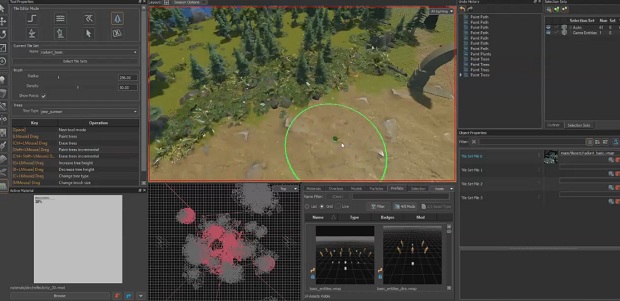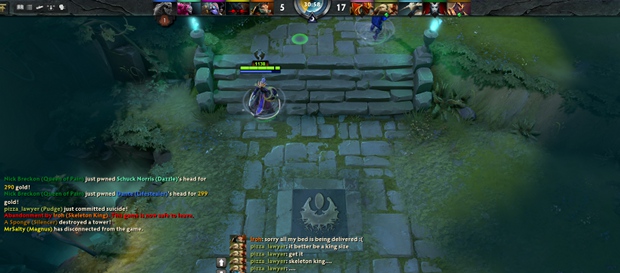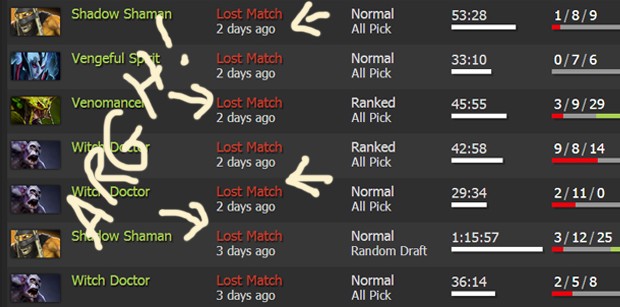

Three Lane Highway is Chris' weekly column about Dota 2.
Dota 2's popularity goes against all of the received wisdom about game design I can think of. It is complicated and inconsistent and it pushes people to interact in a way that generates all sorts of well-documented discontent. What it offers can't be summed up in a single sentence, and even a documentary dedicated to explaining its competitive side can only do so much to explain what you actually do in the game, or why that is fun.
It's the single game that means the most to me and yet I hate it sometimes; most of my friends don't like it. That's weird, right?
I've picked at this problem in a dozen different ways since starting to write this column. Millions of regular players can't be wrong, but nor can the individuals whose tastes I share who looked at Dota 2 and thought, perhaps reasonably, "no, I am not going to learn the difference between a Scythe of Vyse and a Eul's Scepter while being shouted at by a racist, no thank you."
One possibility is that players are generally more interested in complex systems and difficult games than they're given credit for a trend also demonstrated by the success of DayZ and the survival genre. This is a nice thing to believe, particularly in a world where mainstream game publishers race to pitch lower and lower estimates of players' tastes and capacity to think for themselves. Another, more practical answer is that Dota 2 is popular because it's both enormously varied and completely free, which isn't a common combination. It used to be more so: the kinds of modding scene that created DotA (and Counter-Strike) offered a wealth of diverse experiences that didn't cost you anything. Now, people find some of that variety in a single game.
Dota isn't the same game for everybody that plays it. This is key to understanding why it's so popular and so fractious: for some people, it simply isn't a vastly complicated team strategy game. It's a deathmatch game where you pick the big guy with the hook and try to drag wizards out of the bushes. For others, it's a game where you kill NPCs until you've got an expensive item in all six inventory slots at which point you take part in a single battle to end the game. Some people play solo, some with the same friends every night, others with a rotating cast. There aren't quite as many Dotas as there are people who play it, but there are more than we give it credit for.
Today's announcements made it clear that Valve are going all-in with their support for custom modes. The tools are in place, and they're more powerful than they've ever been. An interface for sharing and playing them will follow shortly. This is both the end of Dota 2 as we understand it and the restoration of the circumstances that created Dota in the first place. I wonder if, in the future, we'll come to to think of the first few years of Dota 2's life as a strange bubble where there was only one game type, divided up into modes by the specific ways that you went about choosing a hero. I wonder what effect this will have on the way people play Dota every day, and on the sense of importance that Valve has invested in those three lanes, that original design, through high-profile tournaments like the International.
Imagine if everybody who locks down mid so that they can play Pudge graduated to Pudge Wars overnight. They won't, I guess, but it's the readiest example. Much of the strife that arises when playing with strangers comes from the sense that you're not playing the same game that there's an invisible distinction between players based on attitude. With custom modes more readily accessible, that distinction becomes something practical, something that designers can design around and players can plan for. It becomes less necessary, because we won't all be forced to play on the same field. The Pudge guys can play Pudge Wars. And they should.
We'll go back to having more than one Dota in reality as well as in theory. Valve's original adoption of the mod had the effect of granting special status to Icefrog's work, which had already come to be thought of as the official iteration of the game. E-sports has a large role to play in that, and arguably the most prominent 'other' form of Dota at the moment is Captain's Mode: it really is its own game, distinct from the All Pick and Random Draft that people play in regular matchmaking. It's the practical divide between competitive Dota and everything else. Soon it'll be the competitive form of classic Dota smaller, in the grand scheme of things while modders slave away at creating something better. The change in scope for Dota as a whole is staggering.
Part of me is going to miss having everybody forced to figure out their place in a single absurdly complicated game. It's this that forms the basis of friendships, that allows you to turn around to anybody in the queue at a Dota event and talk in a common language. It won't fade quickly, not at first it starts small, as custom maps gain traction as the preserve of the curious and the bored but Valve are giving the community the tools it needs to redefine the game at a fundamental level. I'm pretty sure TI5 and 6 will be played on three lanes. TI7, though? We'll see.
To read more Three Lane Highway, click here.













